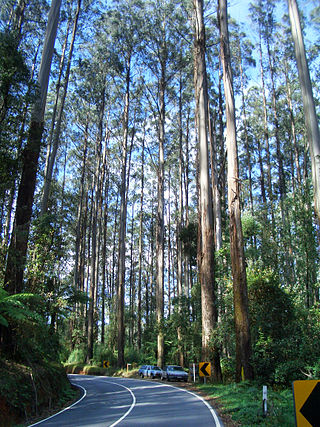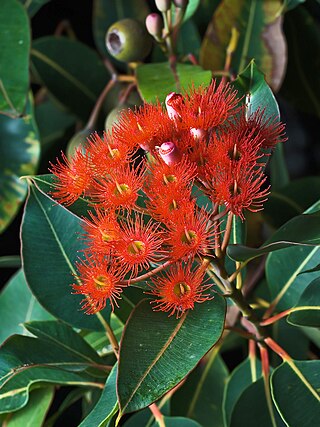
Eucalyptus is a genus of over seven hundred species of flowering trees, shrubs or mallees in the myrtle family, Myrtaceae. Along with several other genera in the tribe Eucalypteae, including Corymbia, they are commonly known as eucalypts. Plants in the genus Eucalyptus have bark that is either smooth, fibrous, hard or stringy, leaves with oil glands, and sepals and petals that are fused to form a "cap" or operculum over the stamens. The fruit is a woody capsule commonly referred to as a "gumnut".

Eucalyptus regnans, known variously as mountain ash, swamp gum, or stringy gum, is a species of medium-sized to very tall forest tree that is native to the Australia states of Tasmania and Victoria. It is a straight-trunked tree with smooth grey bark, but with a stocking of rough brown bark at the base, glossy green, lance-shaped to curved adult leaves, flower buds in groups of between nine and fifteen, white flowers, and cup-shaped or conical fruit. It is the tallest of all flowering plants; the tallest measured living specimen, named Centurion, stands 102 metres tall in Tasmania.

Corymbia ficifolia, commonly known as red flowering gum, is a species of small tree that is endemic to the south-west of Western Australia. It has rough, fibrous bark on the trunk and branches, egg-shaped to broadly lance-shape adult leaves, flower buds in groups of seven, bright red, pink or orange flowers and urn-shaped fruit. It has a restricted distribution in the wild but is one of the most commonly planted ornamental eucalypts.

Quercus suber, commonly called the cork oak, is a medium-sized, evergreen oak tree in the section Quercus sect. Cerris. It is the primary source of cork for wine bottle stoppers and other uses, such as cork flooring and as the cores of cricket balls. It is native to southwest Europe and northwest Africa. In the Mediterranean basin the tree is an ancient species with fossil remnants dating back to the Tertiary period.

The Chavez Ravine Arboretum, in Elysian Park, just north of Dodger Stadium, at 929 Academy Road, Los Angeles, California, contains more than 100 varieties of trees from around the world, including what are believed to be the oldest and largest Cape Chestnut, Kauri, and Tipu trees in the United States. Admission to the arboretum is free.

Acacia auriculiformis, commonly known as auri, karuvel in Tamil Nadu and Karnataka and aakashmani in West Bengal, is a fast-growing, crooked, gnarly tree in the family Fabaceae. It is native to Australia, Philippines, Indonesia, and Papua New Guinea. It grows up to 30 metres (98 ft) tall. Acacia auriculiformis has about 47,000 seeds per kilogram (21,000/lb).

Acacia, commonly known as the wattles or acacias, is a large genus of shrubs and trees in the subfamily Mimosoideae of the pea family Fabaceae. Initially, it comprised a group of plant species native to Africa and Australasia. The genus name is New Latin, borrowed from the Greek ἀκακία, a term used by Dioscorides for a preparation extracted from the leaves and fruit pods of Vachellia nilotica, the original type of the genus. In his Pinax (1623), Gaspard Bauhin mentioned the Greek ἀκακία from Dioscorides as the origin of the Latin name.

Acacia mearnsii, commonly known as black wattle, late black wattle or green wattle, is a species of flowering plant in the family Fabaceae and is endemic to south-eastern Australia. It is usually an erect tree with smooth bark, bipinnate leaves and spherical heads of fragrant pale yellow or cream-coloured flowers followed by black to reddish brown pods. In some other parts of the world, it is regarded as an invasive species.
The greater Brisbane area of Queensland Australia, has many species of indigenous flora. This article links the flora to its geography with:

Vachellia nilotica, more commonly known as Acacia nilotica, and by the vernacular names of gum arabic tree, babul, thorn mimosa, Egyptian acacia or thorny acacia, is a flowering tree in the family Fabaceae. It is native to Africa, the Middle East and the Indian subcontinent. It is also considered a 'weed of national significance' and an invasive species of concern in Australia, as well as a noxious weed by the federal government of the United States.

Senegalia catechu is a deciduous, thorny tree which grows up to 15 m (50 ft) in height. The plant is called khair in Hindi, and kachu in Malay, hence the name was Latinized to "catechu" in Linnaean taxonomy, as the type-species from which the extracts cutch and catechu are derived. Common names for it include kher, catechu, cachou, cutchtree, black cutch, and black catechu.

Angophora floribunda, commonly known as the rough-barked apple, is a common woodland and forest tree of the family Myrtaceae native to Eastern Australia. Reaching 30 m (100 ft) high, it is a large tree with fibrous bark and cream-white flowers that appear over the Austral summer. It grows on alluvial soils on floodplains and along watercourses. Much of the land it grew on has been cleared for agriculture.

Eucalyptus salmonophloia, commonly known as salmon gum, wurak or weerluk or woonert or marrlinja. is a species of small to medium-sized tree that is endemic to Western Australia. It has smooth bark, narrow lance-shaped to curved adult leaves, flower buds in groups of between nine and thirteen, creamy white flowers and hemispherical fruit.

Leucocyanidin is a colorless chemical compound that is a member of the class of natural products known as leucoanthocyanidins.

Leucopeonidin is a leucoanthocyanidin.

Eucalyptus leucophloia, commonly known as snappy gum or migum, is a species of small tree or mallee that is endemic to northern Australia. The indigenous Mangarayi and Yangman peoples know the tree as mirndir, the Ngarluma name it as malygan and Yindjibarndi peoples know the tree as majgan. It has smooth, powdery bark, lance-shaped to egg-shaped adult leaves, flower buds usually in groups of seven, white flowers and cup-shaped, barrel-shaped or hemispherical fruit.

Corymbia ferriticola, commonly known as Pilbara ghost gum, is a species of tree or a mallee that is endemic to Western Australia. It has smooth bark, lance-shaped adult leaves, flower buds in groups of seven, creamy white flowers and shortened spherical to cylindrical fruit.

Eucalyptus diversifolia, commonly known as the soap mallee, coastal white mallee, South Australian coastal mallee, or coast gum is a species of mallee that is endemic to an area along the southern coast of Australia. It has smooth bark, lance-shaped adult leaves, flower buds in groups of between seven and eleven, white to creamy yellow flowers and cup-shaped fruit.

The Southwest Iberian Mediterranean sclerophyllous and mixed forests is a Mediterranean forests, woodlands, and scrub ecoregion in southwestern Europe. It occupies the southwestern Iberian Peninsula, encompassing coastal lowlands and mountains in portions of Portugal and Spain.


















